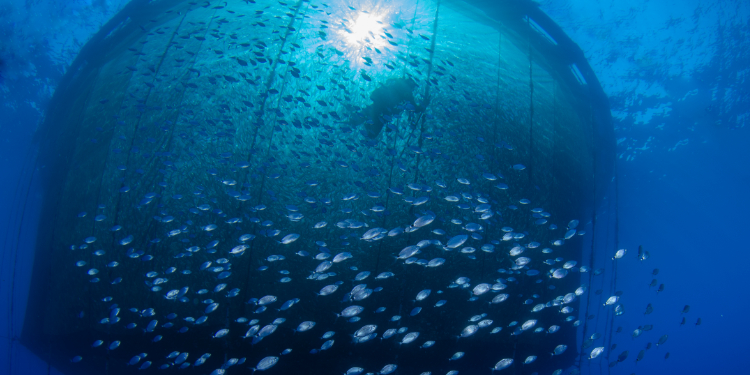Water — The Main Ingredient
At various points in my career, I have heard the argument that freshwater aquaculture makes more sen...

On May 7, near the height of the covid pandemic in the US, President Trump signed an Executive Order (EO) on Promoting American Seafood Competitiveness and Economic Growth. In a Wall Street Journal editorial titled “Trump Lifts the Net Off American Fishing,” top trade and domestic policy and trade advisors Joe Grogan and Peter Navarro made the case for the US, as “an ocean nation” to become a “seafood superpower” and impugning imported seafood products come from farms that “often fail to meet international standards on health, labor and the environment.” Secretary of Commerce Wilbur Ross was also a very strong supporter of the order.
The EO requires the eight Regional Fishery Management Councils to make policy recommendations “to reduce burdens on domestic fishing” in two years. The order aims to improve the competitiveness of American fisheries through deregulation. It also calls for steps to reduce IUU fishing and creates a Seafood Trade Task Force, co-chaired by NOAA, that will develop a comprehensive interagency seafood trade strategy.
Beyond fisheries, there was a potential break in the regulatory logjam constraining offshore aquaculture development. The order initiates a streamlined federal review and approval process of offshore aquaculture projects in federal waters, 3 to 200 mi from the coast. The US Army Corps of Engineers is now mandated to develop a nationwide permit for offshore aquaculture within 90 days. Any environmental review or multi-agency authorization must be completed within two years. The EO was explicit in wanting to remove “outdated and unnecessarily burdensome regulations,” although it did not identify the specific regulations that would be removed or streamlined.
The EO also establishes “aquaculture opportunity zones” that will be identified by federal agencies and designated for offshore aquaculture development. The order calls for the identification of two areas per year for five years and completed environmental site assessments within two years.
The National Oceanic and Atmospheric Administration (NOAA) was designated as the lead agency with authority over aquaculture projects. NOAA has been moving in this direction for many years with a draft regulatory framework for aquaculture in federal waters in the Gulf of Mexico proposed in 2016. NOAA also has considerable marine spatial planning capacity that can be used to identify hotspots of high potential. Last year, NOAA’s National Centers for Coastal Ocean Science released useful site selection and spatial analysis tools, National AquaMapper and OceanReports, that support offshore aquaculture.
The responses were entirely predictable. The pro-aquaculture lobbying group Stronger America Through Seafood, CEO Glen Cooke and industry leader Neil Sims spoke favorably. The industry continues to justify offshore aquaculture on the basis of the nation’s $15 billion seafood deficit, which is overestimated based on re-imports of seafood exports. Furthermore, the products of offshore aquaculture are of high value, designated for restaurant and food service markets, not supermarket commodities like shrimp, salmon and tilapia, so the argument about offshore aquaculture and food security is weak.
Let’s call it what this is, an opportunity and incentive for venture capital to invest in the sector, which has hesitated to do so until now because of high regulatory barriers. It remains to be seen if investors will now come off the sidelines and stake a claim. With an EEZ 1.5 times the area of the continental US, the country has some of the highest offshore aquaculture production potential in the world. The proposed expedited review process for offshore projects will be far more straightforward and streamlined that that for offshore wind. Offshore aquaculture has significant promise to create jobs and support working waterfronts along US coastlines.
In a case of bad timing, at around the same time as the release of the Trump EO in March, Catalina Sea Ranch, the first offshore aquaculture facility to be granted a permit to operate a shellfish farm in federal waters, declared bankruptcy. A $10 million wrongful death suit was filed against the farm owners in December after a loose line caused a fishing boat to capsize, killing one aboard. Poor gear maintenance and ignored permitting requirements ultimately led to farm failure. When pioneering farms like this fail, the setback sets a bad example and sends shockwaves that can stifle further investment. It is unfortunate that the farm failed for all the wrong reasons.
Anti-aquaculture groups belonging to the Don’t Cage Our Ocean Coalition predictably used over-the-top language like “corporate takeover of our oceans” and “floating factory farms.” There are actual or perceived negative effects of offshore aquaculture on the part of commercial fishermen, coastal residents, and those concerned about ocean health that must be addressed to secure the social license to operate. Some environmentalists increasingly recognize that aquaculture is one of the more sustainable ways to grow animal protein, especially for extractive species like shellfish and seaweeds, and support its expansion.
Recognizing that Executive Orders can be rescinded, a bipartisan group in the US Congress has filed a bill (H.R. 6191) called the Advancing the Quality and Understanding of American Aquaculture (AQUAA) Act, which would establish a regulatory pathway for offshore aquaculture in the US EEZ. This would put the initiatives outlined in the recent Executive Order on a more secure footing, assuming Congressional approval is forthcoming.
It’s difficult to know what to make of this EO. On the one hand, it seems that this breaks a regulatory impasse and opens the door wider to offshore aquaculture development. Thus, the President deserves his due. On the other hand, the Trump administration has a long history of rolling back environmental laws and regulations in the name of industry deregulation that have not been favorable to ocean health. Furthermore, the trade war with China has hurt the seafood industry directly. Given the President’s weak approval ratings, it would be unfortunate if public opposition to the President and his agenda would stiffen public opinion against offshore aquaculture.
— John A. Hargreaves, Editor-in-Chief